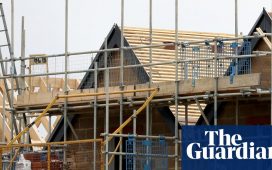Unlock the Editor’s Digest for free
Roula Khalaf, Editor of the FT, selects her favourite stories in this weekly newsletter.
A $10bn US property fund is running low on liquidity as investors demand their money back, threatening a reckoning for a sector rocked by rising debt costs and fears over real estate valuations.
Starwood Real Estate Investment Trust (Sreit), one of the largest unlisted property funds, has drawn more than $1.3bn of its $1.55bn unsecured credit facility since the beginning of 2023 following heavy redemption requests.
The fund, managed by Barry Sternlicht’s Starwood Capital, entered 2023 without having tapped the credit line. But it now has only about $225mn of cash left to draw, according to the latest filings this week.
At the current pace of redemptions, Sreit would run out of credit and cash in the second half of this year unless it borrows more or sells more property assets.
Both Starwood’s fund and a larger rival run by Blackstone Group raised and invested tens of billions of dollars in commercial property shortly before US interest rates began to rise in 2022, generating substantial fees for their private equity owners and financial advisers who sell the funds to wealthy clients.
Unlike publicly traded property trusts, in which investors are free to sell shares on an open market, private Reits are able to control withdrawals and avoid a fire sale of assets.
But investors have still managed to pull billions annually from the Starwood and Blackstone funds amid mounting concerns about property valuations.
Last year, investors withdrew $2.6bn from Sreit and $12.4bn from Breit, Blackstone’s property fund. While redemptions at Breit have slowed markedly in recent months, allowing it to meet monthly withdrawal requests in full for the first time since late 2022, those at Sreit remain at record highs.
Blackstone has convinced some investors it will weather the storm in commercial property partly because it has less exposure than Starwood to sectors such as US apartments and more to hot areas such as data centres.
In the first quarter of 2024, Miami-based Starwood granted a diminishing portion of redemption requests. Investors asked for $1.3bn of their money back, but received only $501mn on a pro-rata basis because of a cap on quarterly withdrawals set at 5 per cent of net assets. In March, only about a quarter of such requests were satisfied.
The Reit’s overall liquidity stood at $752mn on April 30, made up of $446mn in cash on hand, the $225mn of available borrowing on its credit line and about $45mn of debt securities available for sale, according to a securities filing made on Wednesday. However, a separate filing on Monday showed that Sreit was due to meet almost another $200mn in redemptions on May 1, quickly depleting that cash balance.
“Liquidity isn’t something that people think about on the way up but it can become a concern suddenly,” said Phil Bak, chief executive of Armada Investors, which invests in listed real estate property trusts. “When it comes to private Reits, liquidity concerns have been dismissed and they will become paramount again.”
Starwood declined to comment.
A person familiar with the fund said it would have greater liquidity later this month after asset sales that would soon close. Starwood could sell other assets to raise cash, this person said. The fund has also announced a plan to dispose of $1bn of property through special tax-efficient deals with wealthy individuals.

The situation also throws a spotlight on leverage and valuation metrics at Sreit, which invests in residential housing, as well as industrial warehouses and self-storage facilities. The portfolio spans apartment blocks in Arizona and logistics centres in Norway. It also includes a loan provided to Blackstone for the acquisition of Australian hotel and casino group Crown Resorts.
US apartment rents could be under pressure this year as a record supply of new homes hits the market in 2024, according to Yardi Matrix, a real estate data provider. Such forecasts have weighed on the valuations of public Reits invested in US multi-family housing, with shares of Mid-America Apartments and Camden Property Trust, down more than a third from their late 2021 peak.
Starwood’s declared net asset value is down more than 16 per cent from its September 2022 peak at nearly $10bn. Private funds have broadly declined to mark down their net asset values as much as listed funds have fallen in value.
Starwood’s high debt load of $15bn also compares unfavourably to borrowings at public Reits, leaving it with a leverage ratio of 57 per cent of its gross assets, roughly twice that of public peers. Limits on how much more leverage it could take on complicate its task in meeting withdrawals: to keep its leverage ratio stable would mean selling about $1.1bn of property to generate $500mn for withdrawals, after debt repayments.
The group sold $2.2bn of property in 2023. Were it to make further property sales at lower valuations than it has assumed, a downward reappraisal of its asset value would also worsen its debt metrics.
Even after last year’s property sales, Sreit’s interest expense rose 12 per from the prior year to a record $154mn in the first quarter of 2024, fuelled by the additional borrowings from its credit facilities, on which it pays interest at more than 7.5 per cent.










